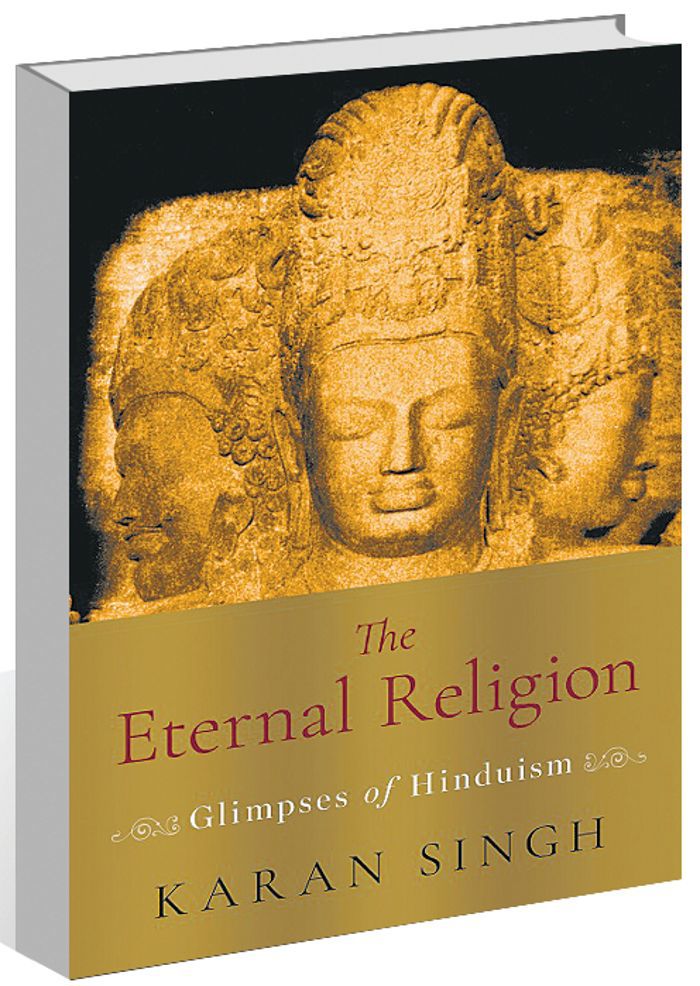The Eternal Religion: Glimpses of Hinduism by Dr Karan Singh. Speaking Tiger. Pages 250. Rs 599
Book Title: The Eternal Religion: Glimpses of Hinduism
Author: Dr Karan Singh
Purushottam Agrawal
The volume under review contains some unpublished essays and travelogues by Dr Karan Singh, a respected scholarly proponent of Hinduism. Even though he does not directly respond to “some highly unfortunate and derogatory comments made recently about Sanatana Dharma”, clearly, it is one of the reasons behind publishing these essays. The other, more important one, has to do with the “animated political controversy” about defining Hinduism, which has been going on ‘in India since early 1990’.
Dr Singh unambiguously maintains, “Hinduism is one of the great religions of the world and to seek to confine it to present-day India or to give it an exclusivist and majoritarian interpretation is to do it a disservice.”
He responds to this ‘disservice’ by putting together an ‘overview of Hinduism’ along with essays on Vedanta, yoga, Shiva, Vivekananda and ‘Bhagavadgita’, thus reflecting on “master principles” of Hinduism. Some of the ‘travels of a pilgrim’ (ranging from the cave of Amarnath to the temples in Bali) give an intimate personal touch to his reflections. The Bali travelogue serves as a reminder of ‘disservice’ to Hinduism by putting it at the service of exclusivist, majoritarian ‘nationalism’. Hinduism had been flourishing in these parts for centuries before the American and European Hindutva enthusiasts even saw the light of day.
The ‘master principles’ providing “the key to an understanding of a faith that is bewildering in its apparent diversity and complexity” include the concept of ‘Brahman’ — the undying reality pervading the entire cosmos, its immortal spark in human beings known as ‘Atman’, the ideas of four goals i.e. ‘Purusharthas’ of life and ‘Karma’. This, “far from implying fatalism… gives tremendous responsibility to the individual and places in his own hands the key to his future destiny.” Practical aspects of these principles like yugas, ashramas and varnas also have been explained, and the author clearly describes the caste prejudice related ill-treatment as “a standing disgrace to the Hindu civilisation”.
The basis of master principles of Hinduism i.e. recognition of essential unity and perpetual movement of cosmos is articulated evocatively in ‘Nasadiya Sukta’ (hymn of creation, presented here in translation) from the ‘Rig Veda’. This makes redundant the idea of a ‘creator’ separate from creation. It is due to the crucial difference between ‘Brahman’ and the domineering image of Abrahamic God: “Unlike the Semitic religions, which postulate a sharp dichotomy between good and evil, creation and destruction, Hindu philosophy presents the tremendous concept of a deity in whom all paradoxes are accommodated and resolved, presenting an integrated vision of existence.”
This unique concept of divinity finds fullest expression in the persona of Shiva, who is “surely the most fascinating, enigmatic, powerful and resplendent of all gods in the Hindu pantheon”. Surely, the chapter on him is most engaging, eloquent, almost poetic. Explaining various facets of Shiva’s presence in Hindu imagination, Dr Karan Singh recalls the story of Daksha Prajapati’s yagna, which encapsulates the evolution of Shiva from “the outsider who could not be included in Vedic rituals” to the “predominant feature in classical Hinduism”.
He also points out: “…unlike most other religions, our gods are fond of music and love to dance. Krishna had his famous dances with the gopis, whose mellow and romantic tunes were in keeping with the magical ambience of rural Vrindavan. In sharp contradiction to this is the cosmic dance of Shiva — the Tandava — which includes creation, preservation and destruction and is accompanied by powerful sound and movements… At a time of destruction, he dances the Vinash (or Rudra) Tandava, which represents the annihilation of universe, and when he is in a joyful and creative mood, he dances Ananda Tandava and the ripples of his bliss spread across all creation.”
The author observes: “At its deepest, religion is an uplifting, widening, maturing phenomenon. The mystics of all the world’s great religions are bound by that deepest of all links — spiritual experience. It is the integral concept of religion that has to be reiterated and made part of our educational system and our national life if the virus of communalism is to be finally destroyed.”
The point, however, is that religion has no monopoly over spiritual experience. One can experience the ‘expansion beyond self’ and sensation of being ‘in vast existence’ through literature, music and other creative expressions also. Moreover, the experiences of mystics across religions might be similar, but metaphysics and world outlook of all religions are not. Most importantly, critical scrutiny of any subject of study is the centrepiece of serious academics, and the sentiments of religious believers are too fragile to stand such scrutiny. While appreciating Dr Singh’s suggestion, one has to reiterate the need to first inculcate an open-minded and critical temper in society.
On the whole, this book serves as a welcome rejoinder to various forms of ‘disservice to Hinduism.’














